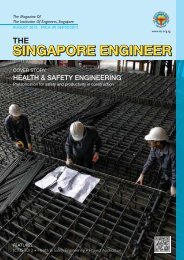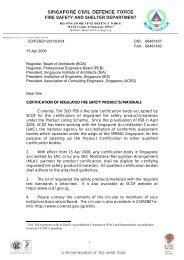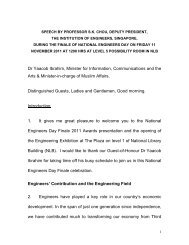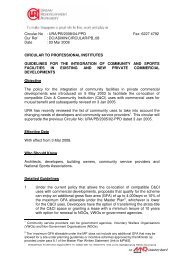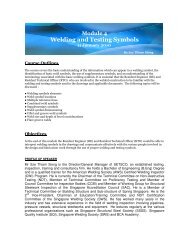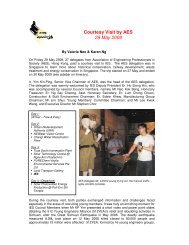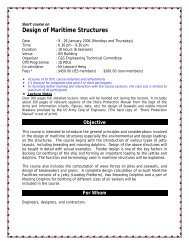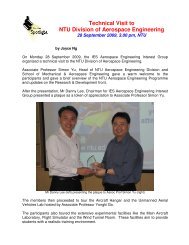civil & structural engineering - Institution of Engineers Singapore
civil & structural engineering - Institution of Engineers Singapore
civil & structural engineering - Institution of Engineers Singapore
You also want an ePaper? Increase the reach of your titles
YUMPU automatically turns print PDFs into web optimized ePapers that Google loves.
INTERVIEW<br />
SIT is also considering the possibility <strong>of</strong> extending the<br />
existing two-year programmes to three or even four years.<br />
The lengthening <strong>of</strong> the course period will allow SIT to take<br />
in students from non-articulating diplomas, who would then<br />
acquire the required knowledge content. SIT would also be<br />
able to impart the s<strong>of</strong>t skills that students need for their<br />
chosen careers.<br />
Q: Could you elaborate on the SIT-DNA and on ‘learning,<br />
unlearning and relearning’?<br />
A: Many higher education institutions are looking to ensure<br />
they educate their students to be relevant and effective in a<br />
world in which change is occurring at an increasing pace and<br />
industries will need to evolve and change constantly.<br />
The work-study model, devised by SIT, encourages students<br />
to take up meaningful work stints as part <strong>of</strong> their university<br />
education.<br />
The SIT-DNA will enable its graduates to be able to boldly<br />
embrace change and to be adaptable. We also want our<br />
graduates to be thinking tinkerers - people who are hands-on,<br />
resourceful and practical.<br />
The importance <strong>of</strong> learning, unlearning and relearning becomes<br />
clear when we realise that with improving healthcare, most <strong>of</strong><br />
us will work for some 40 plus years - nearly three times longer<br />
than the duration <strong>of</strong> our formal education.<br />
So for those who want to succeed, they must be able to deal<br />
with disruption. They will need to know how to learn, unlearn<br />
and relearn, while working.<br />
Unlearning has to do with mindsets and attitudes. It is about<br />
accepting that something you have learnt is no longer useful or<br />
applicable, showing the willingness to accept reality and then<br />
having the courage and fortitude to adapt and change. This can<br />
apply to technical know-how that has become obsolete, or<br />
even when a company has to relocate in order to survive or<br />
take advantage <strong>of</strong> new business opportunities.<br />
After unlearning comes learning and relearning. We constantly<br />
add new skills during our lifetime. As industry, processes and<br />
technology change and evolve, the question is whether or not<br />
our graduates are imbued with the right mindset to adapt to<br />
this new future.<br />
A key feature <strong>of</strong> the SIT pedagogy, moving forward, will be<br />
to ingrain into each and every one <strong>of</strong> our students that life is<br />
going to be about learning on the job, from the job and during<br />
the job.<br />
Q: From an overall perspective, in an uncertain world<br />
economic situation, what are some <strong>of</strong> the challenges<br />
faced by institutions <strong>of</strong> higher learning and how is SIT<br />
addressing them?<br />
A: Challenges faced by institutions <strong>of</strong> higher learning include<br />
having to meet the needs <strong>of</strong> the domestic economy against<br />
an ever-changing world economic situation. As one such<br />
institution, SIT will need to remain nimble and fl exible in terms<br />
<strong>of</strong> programme <strong>of</strong>ferings and, at the same time, be able to train<br />
students to willingly embrace change and be adaptable.<br />
In order to address these challenges, SIT will not have the<br />
traditional faculty/school structures but will create multi-varied<br />
skills clusters to encourage cross-fertilisation.<br />
Our programmes will build on the skills and hands-on<br />
orientation <strong>of</strong> the polytechnic graduates, so that they become<br />
‘thinking doers’. Also, with our industry-driven programmes,<br />
we hope to ensure that SIT graduates have the skills necessary<br />
for the future.<br />
Another challenge is that since industries expect graduates<br />
to be work-ready, there is therefore a need for a different<br />
programme structure to create value-added graduates.<br />
The University <strong>of</strong> Glasgow, UK.<br />
Accordingly, SIT will be working closely with industries to<br />
shape the teaching pedagogy via integrated work-study<br />
learning, project-oriented learning, IT-enhanced self-learning,<br />
and integrated global learning environments.<br />
February 2013 THE SINGAPORE ENGINEER<br />
17



